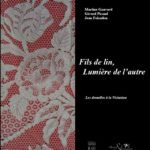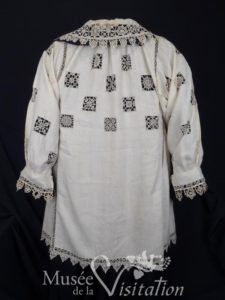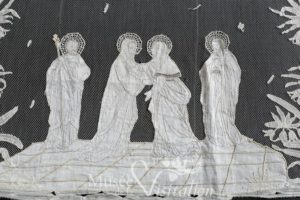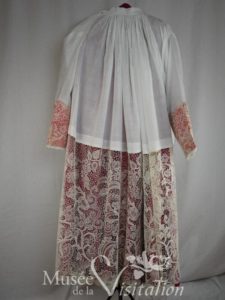 2017 – Child of linen, other Light
2017 – Child of linen, other Light
May 2 to December 24, 2017, Moulins, France
Admission: 4 €
From Tuesday to Saturday from 10am to 12pm and from 2pm to 6pm
Sundays and public holidays from 3 pm to 6 pm
Conference visit by appointment (04 70 44 39 03)
Curators of the exhibition: Gérard Picaud, and Jean Foisselon
 The lace collections
The lace collections
The museum has gradually revealed its collections over the past ten years through thematic exhibitions accompanied by a reference book. Among the 12,000 works managed in Moulins, the quality and the state of conservation of the textile collections have given the Museum a tangible notoriety on the national and international stage, with the general public, researchers and academics. The lace is one of the last pieces in Europe to be completed in a series launched in 2007 for the Order of the Visitation, but which will bring to the national level knowledge on a demanding technique which was at the heart of civilian fashion for almost four centuries.
So what a privilege to allow the discovery of this heritage coming from the whole of France. Because from the outside, girded with its enclosure, each monastery seems impervious to the world and all is oriented towards its life of prayer. But to take a closer look – and this is proven by the collections – the productions of each century are a faithful reflection of the civil and secular modes that shape people’s everyday lives. Modes and tendencies, frequently launched by the world, are nourished and inspired by the spirit of the decorative arts of the time.
The major European centers of production from the 17th to the 20th centuries
Today the word “lace” irresistibly evokes fashion and especially the image of women, the lace-maker, wise and diligent, who executes it and the more coquettish who wears it, frivolous or charming. The historical reality of lace is quite different. Indeed, it is not particularly feminine in its beginnings since the men of the seventeenth century wear it as much as women.
The lace, worn at the sleeves, at the collar, on the headdresses and headdresses plays a capital role . More than jewelery and rich fabrics, lace is truly the outward sign of wealth par excellence for many centuries. And as Anne Kraatz wrote in 1997 in her book Dentelles “even if it is not in fashion, lace will not be outdated. Its name alone will always suffice to evoke in the minds a vision of luxury and elegance inexpressibly linked to the notion of social rank. “
As for its manufacture, it involves much more than diligence brought to a work of a lady, made for pleasure and perhaps by idleness. It takes an apprenticeship that often begins at the age of five. It is a painful job, spoils the eyes and the back and leaves no time for anything else. To feed the clothing fantasies of both men and women, hundreds of thousands of people have worked in lace. Given the market value of this art and the demand on the market, new production centers are developing in Italy, Belgium and France. Everyone is trying to imitate, then to improve the technique of the old centers, Bruges, Alençon, Milan, Brioude, Le Puy-en-Velay.
Thus “the point of France” is regulated by Colbert in its ordinance of August 5, 1665. This term encompassed all the forthcoming “needle and cushion” productions from the royal lace factories.
If the small-sized pieces were intended for clothing (collar, headdress, sleeves), larger footage was also made for furnishings such as toilet table toppings. These large laces are expensive. It is known that Louis XIV bought, during the single month of July, 1666, for 18,491 livres points from France from the royal manufactories. In comparison the annual salary of Charles Le Brun, painter of the king and director of the Gobelins factory, is 11,200 livres.
The Museum of the Visitation has the chance to preserve and be able to present a panel very representative of the diversity of this European production adorned with foliage, inspired by botany, even entomology.
 Transformed Layers
Transformed Layers
Young women entering religion at the Visitation move away from the world, but they keep in touch with their families and many benefactors who materially support the communities. The reading of the Annals of the monasteries and the books of gifts brings out all kinds of people ranging from the great ones of this world to the little people or anonymous donors: sovereigns, clergy – popes, bishops, chaplains and confessors – And especially the families and friends of the religious. The sisters do not only receive furniture or money. Lace, considering their pecuniary value, but also sentimental once they have been worn by family members are offered by these and benefactors. Bridal veils, scarves and mantillas are first used during ceremonial occasions.
Then these garments are transformed to serve Catholic worship. In fact, when a postulant returns to the monastery, she abandons her cloakroom. The beautiful dress worn on the day of the ceremony, but also her other outfits, as the bonnets are then at the disposal of the sister in charge of the works. The sacristy sisters cut them to beautify the ecclesiastical garments (dawn, ratchet …) but also the liturgical linen: veil of tabernacle, tablecloth, etc … Thus “nothing is lost and everything is transformed”.
Sometimes the gifts are kept as is, such as that of the Comtesse de Meuneuf, who in 1753 offers to the Visitation of Rennes the lace of her late husband, but asks that: “The most beautiful must make a cravat for the bust of St. Francis de Sales “, how far the fashion goes!
 Creations Visitandines
Creations Visitandines
Among the themes in our books, the one published in 2008, entitled “Fastes and Exuberance”, dealt with the magnificence displayed in the liturgical ceremonies on the occasion of the feasts of beatification or canonization of the saints of order: St. Francis of Sales in the 17th century, Saint Jeanne de Chantal in the 18th century, then Saint Marguerite-Marie Alacoque in the 19th and 20th centuries.
These works of exceptions made in the most precious materials concern domains as varied as goldsmithing, gold, silver and silk embroidery, painting, illumination, carved-golden wood and are found Of course in the art of lace. The particularity of these works also resides in their excellence, their finesse and personification. Not only are Visitandines able to draw and embroider to perfection, but many master the art of lace with needle or spindle.
The creations of the Visitandines shine by their excellence. Indeed, civilian lace-makers had to produce quality lace at an affordable price and consequently spend a reasonable amount of time. The nun, by virtue of her state of life, finds herself as out of time and free from concern for profitability. Her activity having no mercantile purpose, it is the silent prayer, the contemplation and the gratuitousness which are expressed through all these points, as a thanksgiving, a thanksgiving for God.
This long-suffering for work in a cause that transcends them explains their almost unlimited creativity; Hence these decors abounding with flowers evoking paradise, these ceremonial points which adjoin the technical towers illustrating scenes peculiar to the spirituality of their order. From time to time the chronicles reveal a legitimate pride in their realization.
They perform works of unusual refinement for lace, whose civil techniques are enriched with strictly decorative points, sometimes difficult to see with the naked eye. This virtuosity is the mark of their respect for God and for the saints of their order.